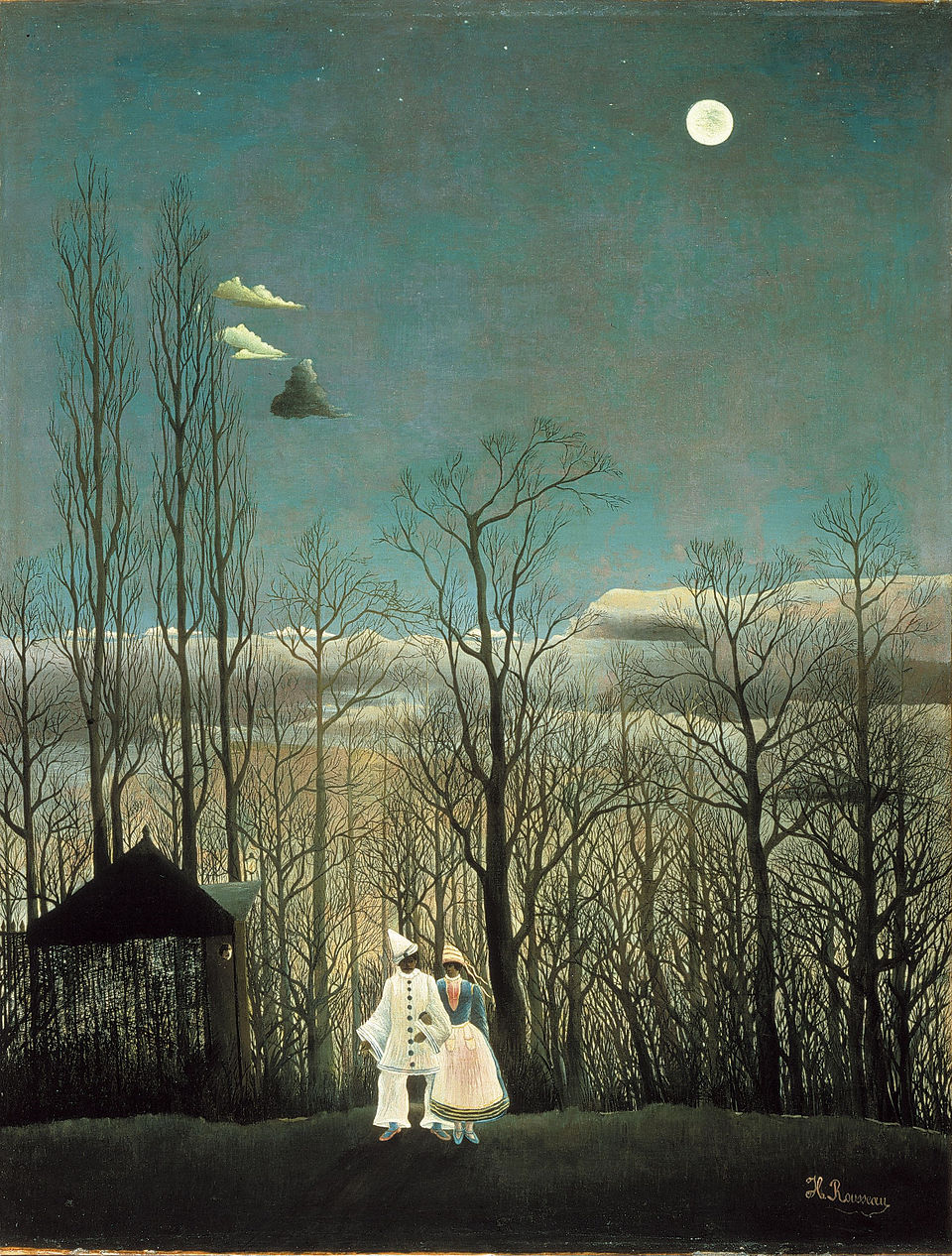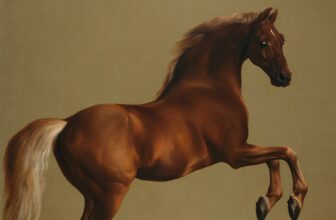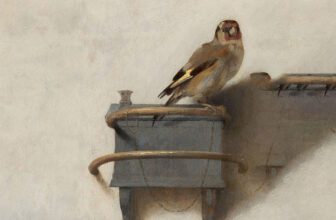
Meaning of Carnival Evening by Félix Rousseau
Beneath the eerie glow of a full moon, deep in a forest that feels both real and imagined, two figures stand still. Dressed in festive costumes, a harlequin and his companion, they seem lost in a moment suspended in time. This is Carnival Evening, a painting created in 1886 by the French post-impressionist artist Henri-Julien-Félix Rousseau, also known simply as Henri Rousseau or “Le Douanier.”
At first glance, the painting may appear deceptively simple, almost naïve. But look again, there is something unsettling in the stillness, a whisper of melancholy in the midst of festivity. Rousseau’s Carnival Evening invites us into a dreamlike world that blends fantasy and reality, celebration and silence. In this story, we’ll unravel the layers of symbolism and artistic technique embedded in this painting and explore what it tells us about the artist, the world he inhabited, and the one he imagined.
Who Was Henri Rousseau?
Henri Rousseau was born in 1844 in Laval, France. Unlike many of his contemporaries, Rousseau did not have formal artistic training. He was a self-taught painter who worked as a toll collector, hence the nickname “Le Douanier,” meaning “the customs officer.” He only began painting seriously in his 40s and was often ridiculed by critics for his “childlike” style. Yet he persisted, driven by a vivid imagination and an unshakable belief in his own artistic vision.
Though dismissed by many in the mainstream art world, Rousseau caught the attention of avant-garde artists such as Pablo Picasso and the surrealists, who recognized the dreamlike intensity and emotional honesty in his work. He became a kind of spiritual predecessor to the modernist and surrealist movements.
The Creation of Carnival Evening
Painted in 1886, Carnival Evening marks an important phase in Rousseau’s development as an artist. This was one of his early major paintings, and it already bears many of the hallmarks of his mature style: flat planes of color, mysterious figures, a poetic sense of composition, and an uncanny, dreamlike atmosphere.
Rousseau did not travel far or study exotic locations firsthand. Instead, he drew inspiration from illustrated magazines, prints, and his own imagination. It is believed he may have seen masquerade scenes or costume illustrations that inspired the harlequin figure. The setting, a forest with bare-branched trees under moonlight, is typical of Rousseau’s ability to evoke both intimacy and otherworldliness.
Despite his lack of formal training, Rousseau was meticulous in his process. He often sketched his subjects multiple times before painting. His use of oil on canvas here shows a confidence in blending foreground and background, as well as a deliberate flattening of perspective that aligns him more with symbolism than realism.
What Is Happening in the Painting?
In Carnival Evening, two central figures dominate the canvas. One is a man dressed in a harlequin costume, checkered red and black, while the other is a woman in a white dress, possibly Pierrette, a traditional female counterpart in commedia dell’arte. They stand motionless in a dark, sparse forest, with thin tree trunks reaching upward like skeletal fingers. Behind them, a small cottage glows with an inviting yellow light, and above, a full moon illuminates the strange tableau with silver-blue light.
Nothing seems to be happening, and that’s precisely where the mystery begins.
The pair appears lost or in search of something. Are they on their way to a carnival or returning from one? Are they stranded in a dream, or are they symbols of loneliness and theatricality? The viewer is left to interpret the scene, which seems frozen between moments, as though time itself has paused to let us look deeper.
The Symbolism of the Forest and the Moon
Rousseau’s forests are not merely backdrops; they are psychological spaces. In Carnival Evening, the bare trees create an eerie, almost claustrophobic feeling. They are stripped of leaves, suggesting winter or emotional barrenness. Forests in Western art and literature often symbolize the unconscious, the unknown, or transformation. Here, the forest could represent a passage through internal or emotional terrain.
The full moon overhead adds to the mystical quality. Traditionally associated with madness, intuition, and the supernatural, the moon casts a cold light that accentuates the surreal quality of the scene. It suggests that this moment exists outside the bounds of the ordinary world, in a liminal space where imagination reigns.
Who Are the Figures and What Do They Mean?
The harlequin and his companion evoke the commedia dell’arte, a form of Italian theater known for masked characters in exaggerated costumes. Harlequin is traditionally a witty servant or trickster, full of agility and mischief. But Rousseau’s harlequin is motionless, melancholic even. His presence seems to defy his typical role.
This inversion of expectation is key to the painting’s emotional impact. The costumes suggest festivity, yet the figures’ expressions and body language convey a deep stillness, perhaps sadness. Their presence in the forest, far from the noise of a carnival, might imply isolation, or the façade we wear even when no one is watching.
Rousseau invites us to consider the masks we wear in our own lives. Are the costumes joyful, or are they a cover for existential uncertainty? Are we witnessing the aftermath of a party or the anticipation of one that will never begin?
Artistic Style: Naïve Art and Beyond
Henri Rousseau is often classified as a practitioner of Naïve Art or Primitive Art, though these labels are somewhat reductive. His lack of academic training led to a unique visual language that rejected traditional perspective and modeling techniques. Instead, he emphasized flat surfaces, bold outlines, and fantastical subject matter.
In Carnival Evening, the spatial arrangement is intentionally unnatural. The trees don’t recede into the distance the way they would in a realist painting. The figures are oddly proportioned and seem to hover against the backdrop rather than integrate into it. These “errors” are precisely what give the painting its dreamlike aura.
Rousseau’s style is closer to Symbolism, a movement that sought to represent internal truths rather than external realities. Like Symbolist poets, Rousseau crafted visual allegories that resonate on a subconscious level. His simplified forms and mystical landscapes feel more akin to dreams than documentary.
Themes: Duality, Isolation, and the Unseen
At its heart, Carnival Evening is about duality. The painting juxtaposes celebration and solitude, fantasy and reality, light and darkness. The carnival costumes signify outward expression, performance, and color, while the forest embodies introspection, stillness, and shadow.
There’s also a haunting sense of isolation. Despite being a pair, the two figures seem emotionally distant. The glowing cottage in the background hints at safety, domesticity, or a past they’ve left behind, or perhaps a future they cannot reach. It beckons, yet remains far away.
Some art historians interpret Carnival Evening as a meditation on the human condition, on the roles we play and the spaces we inhabit between our inner world and the outer social sphere. The figures, dressed to entertain, are alone in the woods. It’s a poetic metaphor for alienation in modern life, one that remains strikingly relevant today.
Reception
When Rousseau unveiled Carnival Evening, the reaction was mixed. Critics were baffled by his technique, often mistaking his intentional flatness and symbolism for ineptitude. But not everyone was dismissive. Avant-garde artists, particularly the surrealists, recognized in Rousseau’s work a purity of vision and a freedom from academic constraints.
Over time, Rousseau came to be seen as a precursor to modernist and surrealist art. His influence can be traced in the dreamscapes of Salvador Dalí, the symbolic forests of Max Ernst, and even the philosophical tension in the work of Giorgio de Chirico.
Carnival Evening, once misunderstood, is now considered one of his most poignant early masterpieces. It captures the ambiguity and emotional depth that would define his later jungle scenes and mythic allegories.
Where Is Carnival Evening Today?
Today, Carnival Evening is housed in the Philadelphia Museum of Art in Pennsylvania, USA. It is part of the museum’s European painting collection and remains a draw for scholars, students, and art lovers who are captivated by Rousseau’s singular vision.
Visitors to the museum often report being mesmerized by the painting’s quiet mystery. It stands as a testament to the idea that emotional truth can transcend technical conventions, that art, even in its simplest forms, can speak volumes.
The Mask That Reveals
In Carnival Evening, Henri Rousseau did more than paint a night scene; he created a visual poem. Through subtle symbolism, stylistic choices, and narrative ambiguity, he invites us to reflect on the nature of identity, the isolation inherent in performance, and the fragile line between dreams and waking life.
Though the painting may lack the grandeur of history painting or the precision of realism, it possesses something far more enduring: a soul. And in that soul, we find a mirror, showing us not only two costumed figures in a forest but also ourselves, searching for meaning beneath the moonlight.




